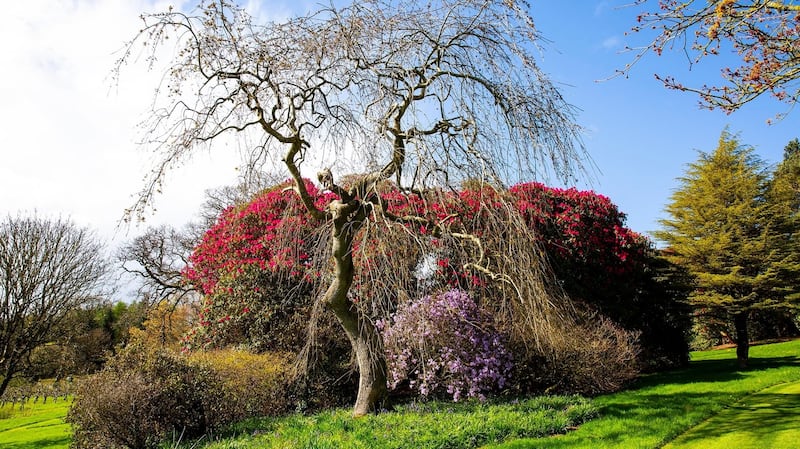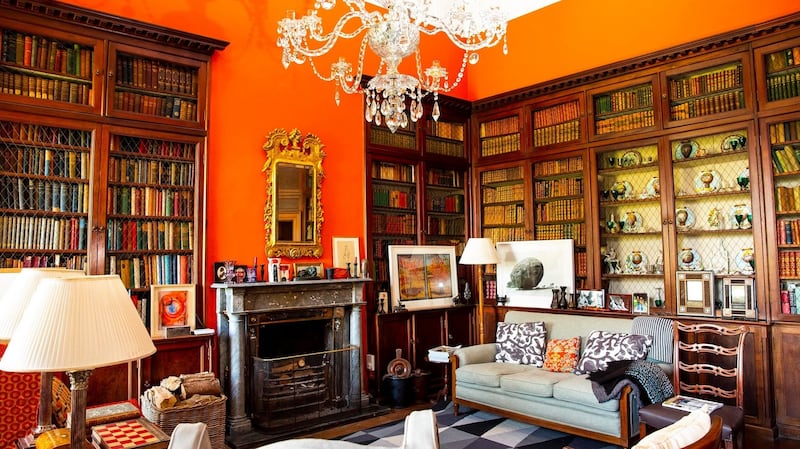Sunlight on the foothills of the Knockmealdown Mountains brightens the landscape into which Cappoquin House and its alluring garden sit as if grown from the heathery uplands behind. The formal entrance gate at the end of the town's main street gives no hint of what lies beyond; the drive which winds through parkland could lead anywhere. That is part of the charm of this place: the layout over five to six acres is designed to encourage people to slow down, to enjoy the exhilaration of discovery, to interrogate the planting and its history as the greensward rises to a palisade of trees marking the boundary between pleasure gardens, farmyard and wilderness.
The aim, really, is beauty
Oddity is one of the delights of Cappoquin and oddly enough it's from a lower level that the gorgeous natural centrepiece of the demesne, the tableau of its perch above the Blackwater valley, is revealed as if emerging from within the house itself, whose windows, like those of Lissadell, "open to the south". From a slanted lawn Sir Charles Keane indicates the distant gable of Dromana House on its crag above the river. Turning slightly to the right he points toward a tower at Lismore Castle. A little to the left the trees obscure the roofs of Tourin. All fortified by FitzGeralds or Butlers or Boyles for wars which throbbed their way for centuries along this valley.

The house stands on the footprint of the old FitzGerald castle whose wall still frames a section of the garden and now, as Charles nods towards Lismore glimpsed between a yew and an Indian horse chestnut, he can't help remarking: "This is all Boyle country. The FitzGeralds ended at the Finisk river." It's a little like Watch on the Rhine, and it's true that the Blackwater has been romantically described as the Rhine of Ireland. A spectacular river at many points on its course through north Cork to west Waterford, it is here at Cappoquin that it makes its sharp turn towards its estuary at Youghal.
Years of neglect
In practical terms, keeping that vista in view, as it were, means quite a bit of cutting back. Home to the Keane family for the last 300 years, this curvaceous landscape was rescued by the late Lady Olivia Keane after the years of neglect which followed the end of the first World War. "My mother began to develop it more vigorously and she had a great concept of design," says Charles Keane, who now lives in the house with his wife Corinne. "She planted well, with an instinct for what looks right, and that's key. The aim, really, is beauty. So if you are on a slope, as we are, you must keep open to the view, which means we're always cutting back."
There’s been some more cutting back since storm Ophelia and a couple of other gales have swept through the garden. The small mercy of these events is that new spaces have opened up extra light and growth and aspects for other opportunities in the demesne, which includes a working arable and dairy farm with a background of mountain forestry and a 100-acre orchard. Hidden from the white-painted courtyard, the beds are thick with vigorous seasonal planting fronting the promise of the luscious profusions of summer.
There are magnificent trees: Japanese cedars, an enormous maple, a Southern beech raised from seeds by Lady Olivia, an oak whose span measures about 30m and which is included in Owen Johnson's Champion Trees of Britain and Ireland. As the ground rises beyond the hedged banks to the bleaching ground, the aspect stretches to reveal various terraces with their variety of rhododendron, azalea, camellia and magnolia and the clusters and tiers of roses, old-fashioned and modern, which create some of the stalwart delights of this remarkable place.
Visitors who wander through this garden will realise that these graduated heights are no happy accident of design. Like the house on the distant crag and the castle embanked low in the valley, the purpose was of warning and defence. Even for commerce, this site was strategic as a trading route and the hillside location, which crucially includes wells, opens out on a panorama not only southwards to the sea but west and east where once the beacons would have flared their signals of alarm.
Republican reprisals
A later flaring was signalled in a more immediate manner. The then senator Sir John Keane was victim, like other proprietors, of Republican reprisals in 1923 when his home was destroyed in an inferno, a beacon to out-do all others. Perhaps as an act of faith in the new Ireland of which he saw himself a part, Sir John quickly began rebuilding. "He had been given warning, and emptied the house in 1922," explains Charles, "but although there were no photographs of the interiors, the Georgian architectural plans and decorative details had been saved, and these were copied by the architect Richard Orpen. "
Sir John refurnished and replenished with the help of local labour, with foundling items from demolished war-damaged houses in London, with retrieved woodwork and panelling, books for the library either inherited or bought from second-hand shops and with ingenious devices such as a concrete floor etched in a convincing diamond pattern.

There is a particularly attractive staircase hall under a high-coffered dome and, on a more domestic level, a passage like an elegant tack-room, lined with a regiment of Wellington boots and hung with equestrian paraphernalia, including the late Sir Richard Keane’s hunting jacket. As the house is open to visitors in groups and by appointment, its skilful remodelling can be enjoyed along with the fascinations of its history, not the least of which is the portrait of a bemedalled General Sir John Keane, Commander of the Army of the Indus in the first Anglo-Afghan War of 1839.
The garden is an incidental beneficiary of the arsonists because the rebuilding more or less turned the house back to front. This allowed a new layout to the courtyard, opening out the shrubberies, flooding the lawns with light and replacing the carriage sweep with a sunken garden at what had been the entrance hall and is now the drawing room. Richard Orpen was a brother of the painter William and must have recognised the dramatic potential of this space where the the valley lies spread out below. It’s an effect to catch the breath, and with this visual coup Orpen reinstated the house as an intimate part of the landscape.
Sunken garden
The sunken garden, alive in autumn with the white dahlia Bishop of Dover, is rimmed with a balustrade copying the roof; below it the ground falls away to the edges of Cappoquin’s main street. Like all good gardens, nothing is static and Charles Keane has plans for a winter garden: “Everyone talks about the gardens in spring, but in winter it’s all about textures, shapes, colours, the whole winter palette, and we can work from the existing shape of the 1850s to terrace the empty lower hillside of the walled garden. We’re open all year round so the garden must look good all year round.”
The bulldozers haven't been brought in yet; gardener Mark Windross, who is to supply the design, is taken up with the work of enhancing the summer borders. "It's true" he says, "this is a great garden in April and May, but mostly the visitors come in the summer months. What we're working on now is increasing the herbaceous planting so that there's continuing colour and interest for people, and also making sure that all the garden isn't seen in just one go."
The entrance fee of €5 is managed by a charity box but both Charles Keane and Mark Windross try to meet visitors, especially if they are serious: “You know they’re serious by the amount of time they take!”
The garden at Cappoquin is open all year, except on Sundays. Visits to Cappoquin House are by appointment











